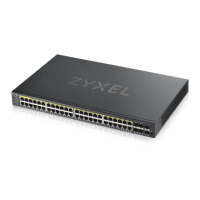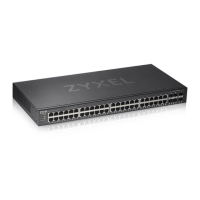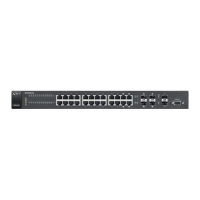Do you have a question about the ZyXEL Communications GS1920-24 and is the answer not in the manual?
Describes the various methods available for managing the switch, including Web Configurator, FTP, SNMP, and Cluster Management.
Provides essential practices for maintaining switch security and operational efficiency.
Details the different ways a switch can be installed, either on a desktop or rack-mounted.
Step-by-step guide for placing and connecting the switch on a desktop surface.
Instructions for securely mounting the switch onto a standard EIA rack.
Describes the components and ports located on the front of the switch.
Details the connectors and components found on the rear of the switch.
Explains the function and status indicators of the various LEDs on the switch.
Provides instructions on how to restore the switch to its original factory default settings.
Details the process of accessing the switch's web interface using a browser.
Describes the main status screen and its navigation components.
Recommends changing the default administrator password for security.
Explains how to save configuration changes to non-volatile memory.
Instructions for resetting the switch to factory default settings.
Demonstrates the process of creating a VLAN and assigning ports to it.
Explains how to assign a Port VLAN ID (PVID) to incoming untagged frames.
Details how to configure the switch's IP address for management purposes.
Provides a step-by-step guide for configuring DHCP snooping on the switch.
Explains how to configure the switch to act as a DHCP relay agent.
Introduces the ZON Utility for device detection, basic settings, and batch firmware upgrades.
Describes how to view and manage neighboring devices using LLDP.
Explains how to view port statistics and status information on the switch.
Details how to view system information like firmware version and MAC address.
Covers configuring general settings such as system name, time, and location.
Explains settings for VLAN type, GARP timers, and priority queue assignment.
Covers configuring the switch IP address, default gateway, and DNS server.
Details how to configure settings for individual switch ports.
Provides information on Power over Ethernet status and management for PoE models.
Covers configuring global IPv6 settings and interface parameters.
Explains how to view IEEE 802.1Q VLAN parameters and access VLAN setup screens.
Details the steps for configuring a static VLAN for the switch.
Describes how to configure static VLAN (IEEE 802.1Q) settings on a port.
Explains grouping traffic into logical VLANs based on source IP subnets.
Describes grouping traffic into logical VLANs based on specified protocols.
Covers VLANs where packet forwarding decisions are based on MAC address and port.
Explains assigning untagged packets to VLANs based on source MAC address.
Details how to configure forwarding rules based on static MAC addresses.
Explains how to configure rules to forward specific multicast frames to ports.
Describes how to create rules for traffic filtering based on MAC addresses.
Guides on activating STP modes like RSTP, MRSTP, or MSTP on the switch.
Details the settings for configuring Rapid Spanning Tree Protocol (RSTP).
Explains how to configure Multiple Rapid Spanning Tree Protocol (MRSTP).
Provides instructions for configuring Multiple Spanning Tree Protocol (MSTP).
Details how to cap the maximum bandwidth for incoming and outgoing traffic flows on ports.
Explains how to limit broadcast, multicast, and DLF packets per second on ports.
Guides on selecting a monitor port and specifying traffic flow for examination.
Details how to configure static link aggregation for logical, higher-bandwidth links.
Explains how to enable Link Aggregation Control Protocol (LACP) for dynamic aggregation.
Guides on activating port authentication methods and configuring RADIUS server settings.
Details on how to enable IEEE 802.1x security on the switch and ports.
Explains how to enable and assign a guest VLAN to a port for unauthenticated access.
Provides instructions on enabling port security and managing MAC address learning.
Details how to define classifiers and specify actions for traffic flows.
Explains how to view and modify existing classifier configurations.
Guides on configuring policy rules to ensure traffic flows receive specific network treatment.
Details how to set priorities for switch queues to distribute bandwidth.
Covers configuration for IGMP, MLD, and multicast VLAN setup.
Explains how to configure IGMP snooping for efficient multicast traffic forwarding.
Details the configuration for IPv6 MLD snooping-proxy functionality.
Guides on creating multicast VLANs and setting receiver/source ports for MVR.
Covers configuration settings for RADIUS servers used for authentication.
Details the configuration settings for TACACS+ servers used for authentication.
Specifies authentication and authorization methods and database priority.
Shows current bindings for DHCP snooping and ARP inspection.
Details managing static bindings for DHCP snooping and ARP inspection.
Enables DHCP snooping and configures the database and default DHCP server.
Specifies whether ports are trusted or untrusted for DHCP snooping.
Enables DHCP snooping on VLANs and configures DHCP relay agent option 82.
Enables ARP inspection and configures filter aging time and log settings.
Specifies trusted/untrusted ports for ARP inspection and packet rate limits.
Provides instructions for enabling loop guard on the switch and specific ports.
Details how to enable layer 2 protocol tunneling and specify encapsulation MAC address.
Configures the switch to provide subscriber information to PPPoE termination servers.
Specifies trusted/untrusted ports and adds extra info to PPPoE discovery packets.
Configures PPPoE IA settings applicable to a specific VLAN on a port.
Enables the PPPoE Intermediate Agent on a VLAN and specifies Circuit/Remote IDs.
Views status of control packets exceeding rate limits and related information.
Limits the rate of control packets (ARP, BPDU, IGMP) delivered to the CPU.
Configures detection of control packets exceeding rate limits and actions to take.
Sets the switch to automatically undo actions after an error condition is resolved.
Details how to configure port isolation within a VLAN using promiscuous and isolated ports.
Explains how to configure Energy Efficient Ethernet (EEE) features to reduce power consumption.
Provides an overview of the available LLDP configuration and status screens.
Displays a summary of the switch's LLDP status and detailed port information.
Shows LLDP status information received from neighboring switches.
Covers the global configuration settings for LLDP on the switch.
Details the configuration parameters for LLDP-MED features.
Explains how to set up network policies for LLDP-MED applications.
Covers configuration of location information for LLDP-MED endpoint devices.
Details how to configure static routes for IPv4 traffic forwarding.
Guides on activating DiffServ to apply marking rules or IEEE 802.1p priority mapping.
Explains how to map DSCP values to IEEE 802.1p priority levels for traffic prioritization.
Covers global and VLAN-based DHCP configuration options.
Details configuring DHCP relay for clients and DHCP server communication.
Explains how to create and apply DHCPv4 option 82 profiles.
Covers configuring DHCP settings based on the VLAN domain of DHCP clients.
Guides on configuring DHCPv6 relay settings for specific VLANs.
Covers checking system logs, pinging IP addresses, and performing port tests.
Explains how to configure the device's system logging settings.
Covers configuring a list of external syslog servers for log collection.
Provides information on the switch's role within the cluster and member status.
Guides on configuring cluster manager and member settings.
Explains how to check MAC address entries and identify if they are dynamic or static.
Details how to view IP-to-MAC address mappings and remove dynamic ARP entries.
Explains how to view IPv6 path MTU information on the switch.
Shows how to copy settings from a source port to destination ports.
Explains how to view IPv6 neighbor information on the switch.
Troubleshooting steps for power, hardware connection, and LED behavior issues.
Addresses common issues related to accessing the switch via IP address or login credentials.
Troubleshooting steps for lost configuration settings after a switch restart.
Lists essential details needed when contacting customer support for assistance.
Provides contact information for ZyXEL's global headquarters and regional offices.
Explains the structure and format of IPv6 addresses.
Describes the unique link-local address used for local network identification.
Covers the DHCPv6 protocol for automatic IPv6 address assignment.
Details the copyright notice for the publication's content.
Outlines ZyXEL's liability limitations regarding product application and use.
Lists registered trademarks and other mentioned trademarks for identification.
Provides FCC and CE mark information regarding device compliance.
| Brand | ZyXEL Communications |
|---|---|
| Model | GS1920-24 |
| Category | Switch |
| Language | English |











